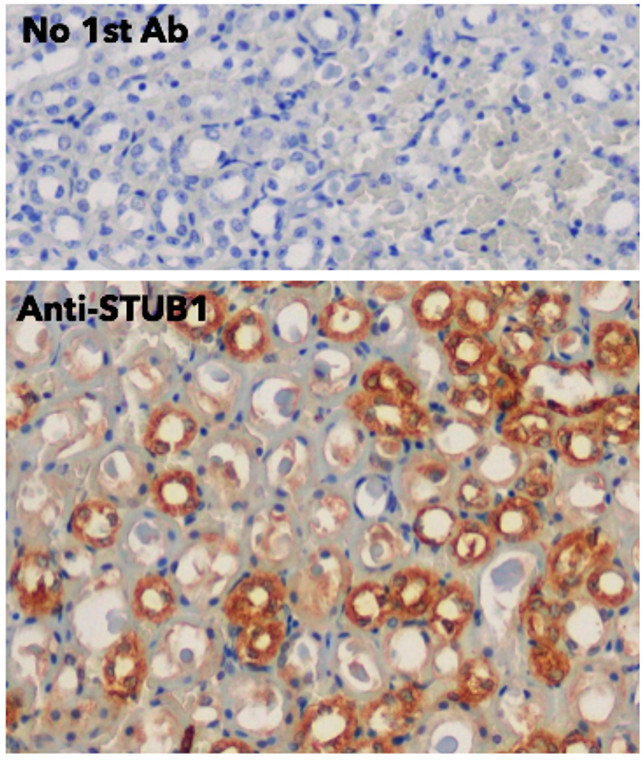| Host: |
Goat |
| Applications: |
WB/IHC-F/IHC-P |
| Reactivity: |
Human/Rat/Mouse/Monkey/Canine |
| Note: |
STRICTLY FOR FURTHER SCIENTIFIC RESEARCH USE ONLY (RUO). MUST NOT TO BE USED IN DIAGNOSTIC OR THERAPEUTIC APPLICATIONS. |
| Short Description: |
Goat polyclonal antibody anti-STIP1 homology and U-box containing protein 1, E3 ubiquitin protein ligase is suitable for use in Western Blot, Immunohistochemistry and Immunohistochemistry research applications. |
| Clonality: |
Polyclonal |
| Conjugation: |
Unconjugated |
| Isotype: |
IgG |
| Formulation: |
PBS, 20% Glycerol and 0.05% Sodium Azide. |
| Purification: |
This antibody is epitope-affinity purified from goat antiserum. |
| Concentration: |
3 mg/ml |
| Dilution Range: |
WB 1:500-1:5000IHC-F 1:250-1:1000IHC-P 1:250-1:1000 |
| Storage Instruction: |
For continuous use, store at 2-8 C for one-two days. For extended storage, store in-20 C freezer. Working dilution samples should be discarded if not used within 12 hours. |
| Gene Symbol: |
STUB1 |
| Gene ID: |
10273 |
| Uniprot ID: |
CHIP_HUMAN |
| Accession Number: |
ENSG00000103266 |
| Specificity: |
Detects endogenous levels of STUB1 by Western blot. |
| Immunogen: |
Purified recombinant human STUB1 protein produced in E. coli. |
| Immunogen Sequence: |
MKGKEEKEGGARLGAGGGSP EKSPSAQELKEQGNRLFVGR KYPEAAACYGRAITRNPLVA VYYTNRALCYLKMQQHEQAL ADCRRALELDGQSVKAHFFL GQCQLEMESYDEAIANLQRA YSLAKEQRLNFGDDIPSALR IAKKKRWNSIEERRIHQESE LHSYLSRLIAAERERELEEC QRNHEGDEDDSHVRAQQACI EAKHDKYMADMDELFSQVDE KRKKRDIPDYLCGKISFEL |
| Tissue Specificity | Expressed in differentiated myotubes (at protein level). Highly expressed in skeletal muscle, heart, pancreas, brain and placenta. Detected in kidney, liver and lung. |
| Post Translational Modifications | Monoubiquitinated at Lys-2 following cell stress by UBE2W, promoting the interaction with ATXN3. Auto-ubiquitinated.mediated by UBE2D1 and UBE2D2. |
| Function | E3 ubiquitin-protein ligase which targets misfolded chaperone substrates towards proteasomal degradation. Collaborates with ATXN3 in the degradation of misfolded chaperone substrates: ATXN3 restricting the length of ubiquitin chain attached to STUB1/CHIP substrates and preventing further chain extension. Ubiquitinates NOS1 in concert with Hsp70 and Hsp40. Modulates the activity of several chaperone complexes, including Hsp70, Hsc70 and Hsp90. Mediates transfer of non-canonical short ubiquitin chains to HSPA8 that have no effect on HSPA8 degradation. Mediates polyubiquitination of DNA polymerase beta (POLB) at 'Lys-41', 'Lys-61' and 'Lys-81', thereby playing a role in base-excision repair: catalyzes polyubiquitination by amplifying the HUWE1/ARF-BP1-dependent monoubiquitination and leading to POLB-degradation by the proteasome. Mediates polyubiquitination of CYP3A4. Ubiquitinates EPHA2 and may regulate the receptor stability and activity through proteasomal degradation. Acts as a co-chaperone for HSPA1A and HSPA1B chaperone proteins and promotes ubiquitin-mediated protein degradation. Negatively regulates the suppressive function of regulatory T-cells (Treg) during inflammation by mediating the ubiquitination and degradation of FOXP3 in a HSPA1A/B-dependent manner. Catalyzes monoubiquitination of SIRT6, preventing its degradation by the proteasome. Likely mediates polyubiquitination and down-regulates plasma membrane expression of PD-L1/CD274, an immune inhibitory ligand critical for immune tolerance to self and antitumor immunity. Negatively regulates TGF-beta signaling by modulating the basal level of SMAD3 via ubiquitin-mediated degradation. May regulate myosin assembly in striated muscles together with UBE4B and VCP/p97 by targeting myosin chaperone UNC45B for proteasomal degradation. Mediates ubiquitination of RIPK3 leading to its subsequent proteasome-dependent degradation. |
| Protein Name | E3 Ubiquitin-Protein Ligase ChipAntigen Ny-Co-7Cll-Associated Antigen Kw-8Carboxy Terminus Of Hsp70-Interacting ProteinRing-Type E3 Ubiquitin Transferase ChipStip1 Homology And U Box-Containing Protein 1 |
| Database Links | Reactome: R-HSA-2173788Reactome: R-HSA-5213460Reactome: R-HSA-5357905Reactome: R-HSA-5675482Reactome: R-HSA-8863795Reactome: R-HSA-8939902Reactome: R-HSA-8948751Reactome: R-HSA-983168 |
| Cellular Localisation | CytoplasmNucleusTranslocates To The Nucleus In Response To Inflammatory Signals In Regulatory T-Cells (Treg) |
| Alternative Antibody Names | Anti-E3 Ubiquitin-Protein Ligase Chip antibodyAnti-Antigen Ny-Co-7 antibodyAnti-Cll-Associated Antigen Kw-8 antibodyAnti-Carboxy Terminus Of Hsp70-Interacting Protein antibodyAnti-Ring-Type E3 Ubiquitin Transferase Chip antibodyAnti-Stip1 Homology And U Box-Containing Protein 1 antibodyAnti-STUB1 antibodyAnti-CHIP antibodyAnti-PP1131 antibody |
Information sourced from Uniprot.org
12 months for antibodies. 6 months for ELISA Kits. Please see website T&Cs for further guidance











